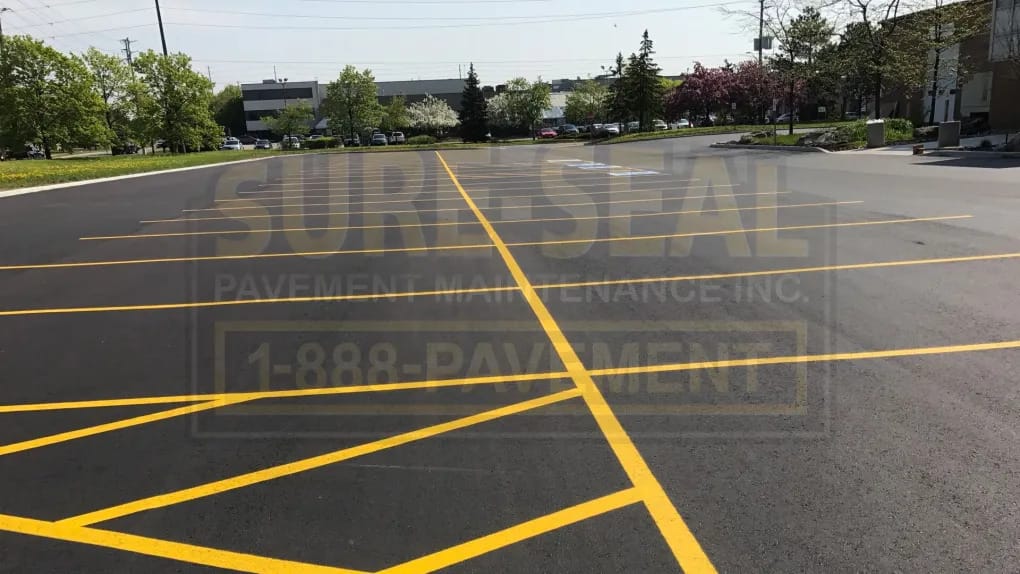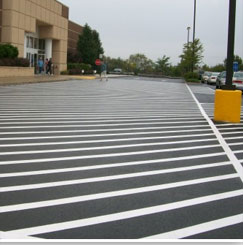A Comprehensive Guide to the most effective Practices in Roadway Painting for Public Highways
Efficient road paint is a vital part in guaranteeing public safety and ideal traffic circulation on freeways. This conversation will explore the very best practices in this area, consisting of the selection of ideal products and progressed application techniques. It is necessary to take into consideration not only the prompt influence of roadway markings but also their long-term maintenance and presence under differing environmental conditions. Comprehending these elements can significantly affect the performance of road markings, yet many are not aware of the nuances entailed. As we think about these best practices, the ramifications for mishap reduction and general road functionality will end up being apparent.
Importance of Roadway Painting
Roadway paint plays a critical function in keeping traffic safety and effectiveness, with research studies indicating that well-marked roads can minimize crashes by up to 30%. The clear distinction of lanes, pedestrian crossings, and various other vital markings serves to direct drivers and pedestrians, cultivating a foreseeable atmosphere when traveling. This predictability is crucial for efficient navigating and helps reduce complication, which can typically result in crashes.
In addition, roadway markings are instrumental in conveying important information, such as rate limitations and directional advice. They improve presence, especially in adverse climate condition or during nighttime driving. The visibility of reflective materials in roadway paints even more boosts presence, permitting drivers to determine important markings that influence their actions on the road.

Choosing the Right Products
Selecting appropriate products for road paint is vital to accomplishing resilient and effective markings. The selection of materials straight affects the presence, longevity, and security of road markings. Typical alternatives consist of water-based paints, solvent-based paints, and thermoplastic materials, each with unique residential properties and applications.
Water-based paints are environmentally friendly, quick-drying, and suitable for many weather condition problems, making them suitable for city settings. However, they might need more constant maintenance as a result of damage. Solvent-based paints, while offering excellent adhesion and resilience, can pose environmental and health issues because of volatile natural compounds (VOCs)
Thermoplastic materials are significantly prominent because of their resilience and durable efficiency. These materials are heated up before application, enabling a solid bond with the sidewalk. Their reflective residential or commercial properties enhance exposure, especially in the evening.
When selecting products, aspects such as traffic volume, climate problems, and the details kind of road should be thought about. Conducting comprehensive research study and consulting with makers can assist make sure that the selected materials fulfill neighborhood guidelines and standards, inevitably contributing to safer roads and improved driver awareness.
Effective Application Strategies
Effective application strategies play a crucial function in making certain that road markings accomplish ideal efficiency and longevity. This technique reduces overspray and ensures that the paint is applied consistently, which is necessary for preserving roadway security.
Before application, it is important to prepare the surface area adequately. This includes cleansing the road of dampness, debris, and oil to improve bond. In addition, temperature and humidity need to be thought about during the application procedure to accomplish the ideal outcomes.
Making use of the proper devices is likewise critical. Line stripers furnished with flexible sizes enable precise markings that comply with regulative criteria. In addition, it is important to calibrate the equipment frequently to guarantee consistency in paint thickness.
Timing and Ecological Factors
Correct timing and consideration of ecological elements are necessary for the successful application of roadway markings. The efficiency of road paint greatly depends on wind, temperature level, and humidity problems at the time of application. Preferably, temperatures should be between 50 ° F and 85 ° F(10 ° C to 29 ° C) for ideal adhesion and curing. When temperatures are also reduced, paint might not treat appropriately, leading to early wear and reduced presence.
Moisture degrees likewise play a critical function; high moisture can prevent drying out times, while excessively dry problems may trigger fast dissipation of solvents, impacting the paint's efficiency. Wind can introduce impurities and particles, possibly compromising the high quality of the markings. As a result, it is suggested to select tranquil days for application.

In addition, thinking about seasonal variants is vital. Roadway painting throughout damp seasons may lead to washouts, while severe warm can cause paint to blister. Scheduling painting projects throughout favorable climate condition can dramatically boost the durability and efficiency of roadway markings. By carefully examining these elements, agencies can guarantee that road markings are applied efficiently and maintain their presence and sturdiness with time.
Maintenance and Durability Approaches

One effective approach is to carry out an organized painting program based upon website traffic volume and ecological factors - Parking lot line striping. Greater web traffic areas may require even more constant upkeep to neutralize the erosive effects of automobiles and weather problems. Furthermore, making use of long imp source lasting materials, such as polycarbonate and epoxy paints, can dramatically prolong the lifespan of road markings
Cleaning road surface areas to get rid of debris and impurities is another crucial element of maintenance. This makes certain optimum adhesion of brand-new paint and boosts the overall effectiveness of the markings. Additionally, employing sophisticated modern technologies, such as automatic radar, can streamline the tracking process and optimize upkeep timetables.
Including these strategies will certainly not just enhance the presence and safety of road markings but also lower long-term costs connected with constant repainting and repair work. (Road painting services)
Verdict
View Line painting Abbotsford in a full screen map
The choice of proper materials, integrated with effective see here application strategies and consideration of ecological aspects, adds to the toughness and visibility of road markings. Routine upkeep and assessments additionally expand the life-span of these markings, ultimately reducing mishaps and enhancing general roadway usability.
The existence of reflective materials in road paints additionally enhances presence, allowing vehicle drivers to recognize crucial markings that influence their actions on the roadway.
Selecting appropriate materials for roadway painting is necessary to attaining effective and sturdy markings.While the preliminary application of roadway markings is vital, continuous maintenance approaches are equally important to ensure their longevity and visibility. Furthermore, the use of sturdy products, such as polycarbonate and epoxy paints, can dramatically expand the life expectancy of roadway markings.
The option of proper products, incorporated with reliable application strategies and consideration of environmental variables, adds to investigate this site the toughness and exposure of road markings.